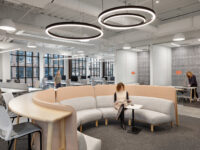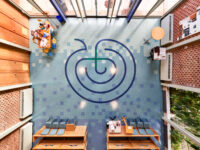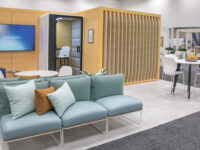The Impact of AI on Work
The rise of AI has rapidly transformed the workplace, streamlining administrative and organizational tasks that once consumed hours of human effort. From automating scheduling to managing data-driven insights, AI allows employees to focus on what truly matters: collaboration, creativity, and meaningful connections.
AI integrations work to enhance, rather than replace, the human experience at work. Designing a workplace that encourages interpersonal engagement, problem-solving, and innovation requires a balance between the newfound efficiency of AI and the irreplaceable value of human interaction.
How Does Design Impact Function?
The working environment is more than just a backdrop. The right commercial space planning transforms an office into purposeful zones, each tailored for different modes of work, from focus work to valuable collaboration. While a team member could do independent work in any space, increased productivity is most probable in a soundproofed booth rather than an open workspace.
AI has changed the way we work, so the office design should follow suit. Reimagining office layouts to blend digital tools with physical spaces creates an environment where technology remains an asset, not a distraction. Human-centered design ensures that, despite the presence of AI, the workplace remains engaging, dynamic, and people-first.
How Do You Create a Human-Centric Workplace?
Design for the Senses
One innately human thing is how our senses shape how we interact with our environment. Designing for all eight senses allows businesses to incorporate human-centered design.
One of the biggest 2025 sensory design trends involves color-drenching. This is the act of using shades of a single color throughout the room design, making the room feel visually stimulating, cohesive, dynamic, and the ideal environment for collaborative creativity.
Avoid Perfectionism
Imperfection is what makes a space feel human. An office designed to be too sleek, symmetrical, or polished can feel uninviting and sterile. Instead, embracing organic materials and textures brings warmth and authenticity to the workplace.
This doesn’t mean the space needs to be unkept or unfinished; an imperfect space leans on the inclusion of materials with natural variations. Create a space that forgets about perfectionism and leans on biophilic design and raw materials to introduce “flaws” that make the space feel more natural. Choose between stone with unique marbling, reclaimed wood with sporadic knots, or asymmetrical greenery to add character to the space while remaining grounded. A workspace should feel lived-in, dynamic, and adaptable rather than a rigid, untouchable showpiece.
Home Sweet Home
Comfort is a catalyst for human interaction. When employees feel at ease, they are more likely to collaborate, share ideas, and engage meaningfully with their colleagues. Drawing inspiration from residential design (such as lounge-style seating, personal decor elements, layered lighting) creates an environment where employees can feel at home. Thoughtfully curated breakout spaces, complete with soft furnishings and personal touches, foster relaxation and conversation.
The Future of Human-Centric Workspaces
AI, alongside all the technology advances yet to come, will continue to shape the way we work, so it’s more important than ever to regularly reevaluate your office design to ensure the best working environment at any given time.
Ready to Rethink Your Office Design?
At King Business Interiors, we specialize in creating workspaces that balance innovation with human connection. If you’re looking to create an office design that complements your automation efforts, our team is here to help. Contact us today to build a workspace that puts people first.



